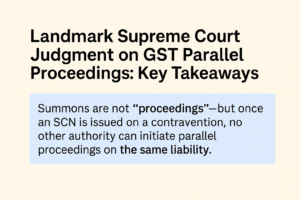The Goods and Services Tax (GST) framework in India is set to undergo significant transformations starting April 1, 2025. These changes aim to enhance security, streamline compliance, and improve the efficiency of tax administration. Businesses and taxpayers must familiarize themselves with these updates to ensure seamless adaptation and continued compliance.
Below is a comprehensive overview of the key GST amendments:
1. Mandatory Multi-Factor Authentication (MFA) for All Taxpayers
Effective April 1, 2025, the implementation of Multi-Factor Authentication (MFA) becomes compulsory for all taxpayers, irrespective of their Annual Aggregate Turnover (AATO). This measure is designed to bolster the security of the GST portal by preventing unauthorized access and safeguarding sensitive financial information. Taxpayers are advised to update their registered contact details and adhere to the MFA setup guidelines provided on the GST portal.
2. Revised E-Way Bill Regulations
- Document Date Restriction: Starting January 1, 2025, E-Way Bills can only be generated for base documents dated within the preceding 180 days. For instance, documents dated before July 5, 2024, will be ineligible for E-Way Bill generation from January 1, 2025. This initiative aims to minimize the issuance of E-Way Bills for outdated transactions, thereby streamlining the logistics process.
- Extension Limitation: The permissible extension period for E-Way Bills is now capped at 360 days from the original date of generation. Consequently, an E-Way Bill generated on January 1, 2025, can only be extended up to December 25, 2025. This change ensures consistency and reduces potential misuse of extensions.
3. Sequential Filing Requirement for GSTR-7
From April 1, 2025, taxpayers are mandated to file GSTR-7 returns sequentially. GSTR-7 pertains to tax deduction at source (TDS) under GST. This sequential filing requirement is intended to enhance the accuracy of TDS reporting and facilitate timely reconciliation, thereby improving the efficiency of tax collections.
4. Biometric Authentication Facility for Directors
Commencing March 1, 2025, the GST Network (GSTN) introduces a facility enabling Promoters and Directors of companies to complete biometric authentication at any GST Suvidha Kendra (GSK) within their home state. This initiative simplifies the authentication process, allowing company officials to undergo verification at a convenient location, thus enhancing compliance efficiency.
5. GST Registration Process Updates
As per the amendments to Rule 8 of the CGST Rules, 2017, applicants opting out of Aadhaar authentication are required to visit a GSK for photo capture and document verification. This procedural update aims to strengthen the verification process during GST registration, ensuring the authenticity of applicants and reducing fraudulent registrations. LinkedIn
6. Increased GST Rate on Sale of Used Cars
Effective April 1, 2025, the GST rate on the sale of used cars will increase from 12% to 18%. This adjustment impacts the pre-owned car market, potentially leading to higher tax liabilities for businesses dealing in used vehicles. Stakeholders in this sector should reassess their pricing strategies and tax planning to accommodate this change.
7. GST Waiver Schemes SPL01 and SPL02
Businesses that have settled all tax dues up to March 31, 2025, may be eligible for a GST waiver under schemes SPL01 or SPL02. To avail of this benefit, eligible businesses must apply within three months of the new fiscal year till June 2025. This initiative offers a tax relief opportunity for compliant taxpayers, encouraging the timely settlement of dues.
Conclusion
The forthcoming GST amendments reflect the government’s commitment to enhancing the tax system’s security, compliance, and efficiency. Businesses and taxpayers must proactively understand and implement these changes to ensure uninterrupted operations and adherence to the new regulations. Staying informed and prepared will facilitate a smooth transition into this new era of GST compliance.




Add comment